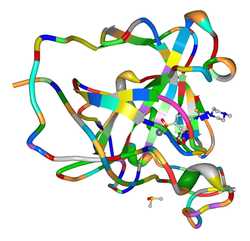Acetazolamide
Acetazolamide, sold under the trade name Diamox among others, is a medication used to treat glaucoma, epilepsy, acute mountain sickness, periodic paralysis, idiopathic intracranial hypertension (raised brain pressure of unclear cause), heart failure and to alkalinize urine.[9][14] Though various websites on the internet report that acetazolamide can be used to treat dural ectasia in individuals with Marfan syndrome, the only supporting evidence for this assertion exists from a small study of 14 patients which was not peer-reviewed or submitted for publication.[17] A 2012 review and meta-analysis found that there was "limited supporting evidence" but that acetazolamide "may be considered" for the treatment of central (as opposed to obstructive) sleep apnea.[21][22] Acetazolamide is not an immediate cure for acute mountain sickness; rather, it speeds up (or, when taking before traveling, forces the body to early start) part of the acclimatization process which in turn helps to relieve symptoms.[25] Common adverse effects of acetazolamide include the following: paraesthesia, fatigue, drowsiness, depression, decreased libido, bitter or metallic taste, nausea, vomiting, abdominal cramps, diarrhea, black stool, polyuria, kidney stones, metabolic acidosis and electrolyte changes (hypokalemia, hyponatremia).The bicarbonate (HCO3−) exits at the basal portion of the cell via sodium (Na+) symport and chloride (Cl−) antiport and re-enters circulation, where it may accept a proton if blood pH decreases, thus acting as a weak, basic buffer.The remaining H+ left over from the intracellular production of carbonic acid (H2CO3) exits the apical (urinary lumen) portion of the cell by Na+ antiport, acidifying the urine.In short, under normal conditions, the net effect of carbonic anhydrase in the urinary lumen and cells of the proximal convoluted tubule is to acidify the urine and transport bicarbonate (HCO3−) into the body.

acetohexamidemethazolamideDrugs.comPregnancycategoryRoutes ofadministrationBy mouthintravenousDrug classCarbonic anhydrase inhibitorATC codeS01EC01Legal status ℞-only℞-onlyPharmacokineticProtein bindingMetabolismElimination half-lifeExcretionIUPAC nameCAS NumberIUPHAR/BPSDrugBankChemSpiderChEMBLPDB ligandCompTox DashboardECHA InfoCardFormulaMolar massMelting pointSMILESglaucomaepilepsyacute mountain sicknessperiodic paralysisidiopathic intracranial hypertensionheart failureopen angle glaucomaacute angle closure glaucomainjection into a veincarbonic anhydraseosmolalityringing in the earskidney problemsliver problemsallergic to sulfonamidesdiuretichydrogen ionsbicarbonateWorld Health Organization's List of Essential Medicinesgeneric medicationaltitude sicknessMénière's diseaseincreased intracranial pressurechronic obstructive pulmonary diseaseoff-labeldural ectasiaMarfan syndromesleep apneamethotrexatehemiplegic migrainekidneysconjugate basecarbonic acidacclimatizationparaesthesiapolyuriakidney stonesmetabolic acidosishypokalemiahyponatremiaStevens–Johnson syndromeanaphylaxisAdrenal insufficiencyAmphetaminesCiclosporinAntifolatestrimethoprimpemetrexedraltitrexedHypoglycemicsLithiumMethenaminePhenytoinPrimidoneQuinidineSalicylatesSodium bicarbonateAnticoagulantscardiac glycosidesribbonball-and-sticksred blood cellsaqueous humourprotonnormal pressure hydrocephalusWorld Health OrganizationNational Institutes of HealthAmerican Cyanamid CompanyClinicalTrials.govAnticonvulsantsGABAergicsGABAARBarbituratesBarbexacloneMetharbitalMethylphenobarbitalPentobarbitalPhenobarbitalCarbamatesCenobamateFelbamateBenzodiazepinesClobazamClonazepamClorazepateDiazepamLorazepamMidazolamNimetazepamNitrazepamTemazepamBromidepotassium bromidesodium bromide